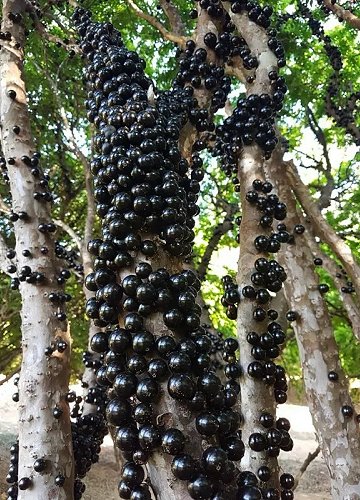
|
|
(Jaboticaba - Plinia cauliflorao). Leaves and fruits.
|
Jaboticaba - Plinia cauliflora
Plinia cauliflora, synonymous with Myrciaria cauliflora and Eugenia
cauliflora, commonly called jaboticaba (also known as Brazilian grape tree), is a tropical to subtropical evergreen tree or large shrub of the family
Myrtaceae, that bears edible, thick-skinned, grape-like purple fruits with a sweet, juicy, gelatinous, white pulp. It is native to the Minas Gerais region of Brazil.
The tree is a slow-growing evergreen, with a dense crown, that can that can grow from 3 - 10 metres tall ( 15 meters
if not
pruned). It is a cauliflorous (flowers and fruits grow directly from the trunks and large branches). It has one or more trunks and the branches emerge close to the ground and spread to give a dense, wide, round and symmetrical crown.
Lanceolate to elliptic, leathery, opposite, evergreen leaves (to 1-4" long) are glossy dark green. The leaves are salmon-pink when young, turning green as they mature.
Yellowish-white flowers emerge in clusters directly on the trunks and branches.
Flowers are followed by globose purple fruits
that appear singly or in clusters. The fruit is a thick-skinned berry and typically measures 3–4 centimetres
in diameter. The fruit resembles a slip-skin grape. It has a thick, purple, astringent skin that encases a sweet, white or rosy pink gelatinous flesh. Embedded within the flesh are one to four large seeds, which vary in shape depending on the species. Jaboticaba seeds are recalcitrant and they lose viability within 10 days when stored at room temperature.
Trees may flower and fruit multiple times throughout the year (up to 5-6 times per year in native Brazil).
The tree prefers moist, rich, lightly acidic soil. It is widely adaptable, however, and grows satisfactorily even on alkaline beach-sand type soils, so long as it is tended and irrigated.
In their native habitat, jaboticaba trees may flower and fruit five to six times throughout the year. Jaboticaba trees are tropical to subtropical plants and can tolerate mild, brief frosts, not below
-3 °C.
The tree has a compact fibrous root system, which makes it suitable for growing in pots or transplanting.
The tree, is native to the states of Rio de Janeiro, Minas Gerais, Goiás and São Paulo in Brazil. Related species in the genus Myrciaria, often referred to by the same common names, are native to Brazil, Argentina, Paraguay, Peru and Bolivia.
Jaboticaba fruits are very popular in Brazil.
The fruit can be eaten raw, made into jellies, syrups and preserves or fermented into wine. Fruit is edible fresh off the tree (pinch each fruit between thumb and forefinger to squeeze out the flavorful pulp without eating the skin which is edible but high in tannin). The purplish, grape-like fruit has a thick skin with a translucent, juicy pulp and a pleasant vinous flavour. In both taste and appearance they are remarkably like some cultivars of the muscadine grape. The fruit is rich in vitamin C.
it is high in antioxidants. The jam is marketed in Brazil as 'Brazilian Grape Jelly'.
Due to the short shelf-life, fresh jaboticaba is rare in markets outside areas of cultivation.
The fruit has been compared to Muscadine grapes, and in Japan the flavor of jaboticaba has been described as similar to that of Kyoho grapes.
Their slow growth and small size when immature make jaboticaba trees popular as bonsai or container ornamental plants in temperate regions. It is a widely used bonsai species in Taiwan and parts of the Caribbean.
The wood is straight-grained, average texture, moderately heavy, but susceptible to wood-eating organisms. It is only used as a fuel and to make charcoal.
Source:
https://en.wikipedia.org/wiki/Jabuticaba
https://www.missouribotanicalgarden.org/PlantFinder/
PlantFinderDetails.aspx?taxonid=302521
https://tropical.theferns.info/viewtropical.php?id=Plinia+cauliflora
